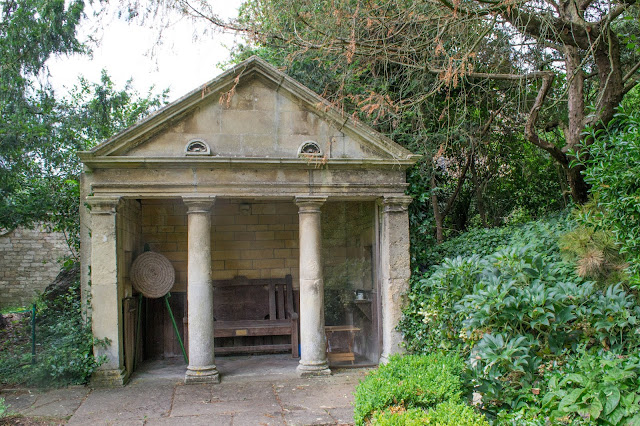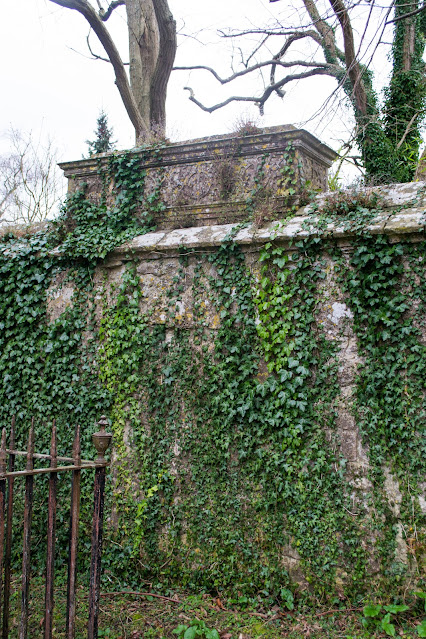A Day Out at The Hall
I've driven past the main gates too many times to count but thought the driveway only led to the Moulton factory. I had absolutely no idea that there was also a house, or that the house and its grounds were quite so grand. This was my first sight of the house, peeping through the trees.

2020 is only the second year that the house and grounds have been open to the public. Covid restrictions were in place so there was a one way route to follow which very quickly led to the front of the house. There is a separate tour of the house, currently on hold until safer times return but which I will do as soon as I can, so for now I will only give a brief history of the house.
The Hall is Jacobean, built c 1610 by John Hall ll, a wealthy clothier (and the family that also owned Great Chalfield Manor). It stayed in his family for about 200 years and then there were numerous changes of ownership until it was purchased in 1848 by Stephen Moulton who was the man responsible for establishing the rubber industry in England. It was during his ownership of The Hall that the building was restored and the formal gardens laid out. His son inherited in 1894 and continued the work to improve the gardens, planting a wide variety of flowers, plants, and tree. The estate eventually passed to Dr Alex Moulton, the great grandson of Stephen Moulton, I think in the 1960s but I can't find the actual date.
The Hall is Jacobean, built c 1610 by John Hall ll, a wealthy clothier (and the family that also owned Great Chalfield Manor). It stayed in his family for about 200 years and then there were numerous changes of ownership until it was purchased in 1848 by Stephen Moulton who was the man responsible for establishing the rubber industry in England. It was during his ownership of The Hall that the building was restored and the formal gardens laid out. His son inherited in 1894 and continued the work to improve the gardens, planting a wide variety of flowers, plants, and tree. The estate eventually passed to Dr Alex Moulton, the great grandson of Stephen Moulton, I think in the 1960s but I can't find the actual date.
Alex Moulton had very strong views on what a garden should look like and according to him "a garden is green shapes and gravel", which explains the absence of flowers. It's not completely lacking in flowering plants as he was a cat lover so planted a row of catmint for his cat, Toby, and there is a rose which I'll mention later. The grounds of The Hall are Grade ll and ll* listed.
These redwoods were planted in the mid 19th century, sadly off the prescribed route so it wasn't possible to explore.
Carrying on from the redwoods led to a gravel path around the edge of the estate which leads up towards the archery lawn.
At the end of that gravel walk we were treated to a sight of the famous Moulton bicycle, designed by Alex Moulton. They are still made today and one part of the factory is still in the corner of the grounds, out of bounds to visitors though. I desperately wanted one of these when I was younger but never got one and I definitely couldn't afford one now - check these prices!
At the end of the gravel walk is the temple where the archery target is stored and where Alex Moulton liked to sit and enjoy a cup of tea. The shelf on the right of the temple is laid out with his kettle and cup as it was in his lifetime, although the primus stove has been removed for safety purposes! We were told that he preferred sugar cubes - you can just make out the blue wrapped sugar cubes on the saucer.
The temple was the perfect place to sit and rest painful knees! It looks out over the archery lawn to the side of The Hall.
This is the only photo that show the detail of the original window glass.
This photo was taken from the top corner of the archery lawn looking down over the lower garden. It shows the 'green shapes' approach loved by Alex Moulton!
On the other side of the house is the pergola, currently lacking the wooden beams which would be on top of the pillars. The pillars are taller than they look in the photo - I was standing at the top of the steps when I took this.
The small building at the end of the pergola is a garage housing this iconic car. Alex Moulton, as some of you may know, was the man who designed the innovative rubber suspension system for the mini.
Beyond this garage is the Moulton Bicycle Factory, not visible from the garden and obviously out of bounds to visitors to The Hall.
The following photo was taken on the croquet lawn, looking back towards the house. The rose you can see on the right of the photo (by the small pillars) is a Juliet rose which was presented to The Hall following a performance of Romeo and Juliet by the local amateur theatre group ... that's where the balcony scene took place although you can't see the balustrade and terrace in this photo. I can see why it's been planted but am disappointed that it isn't in keeping with the "green shapes and gravel" approach of the rest of the grounds.
The croquet lawn leads in to the rock garden which has its own temple. I loved this garden but it is in need of some love and attention.
From here, the route leads to the Japanese garden which I didn't photograph as it was so overgrown. This building dates back to the times when The Hall was owned by clothiers and is a converted cloth drying house.
The Moulton family prided themselves on living next to their Mill, unlike the mill owners in the north of the country who lived miles away from their factories. This is part of the Japanese garden on the edge of the grounds and the modern house visible through the gap in the trees is built of the site of the original Moulton mill ... of course, thanks to the tall trees (and before some trees were damaged and had to be removed) they couldn't actually see the mill at all!
So much of the grounds are in need of restoration. The kitchen garden, the Dutch garden and the Japanese garden are all suffering from years of neglect, as is the boat house. The volunteers are currently focusing on restoring the rock garden so it'll be good to follow their progress over the coming years.

















What a beautiful building and such interesting gardens! Well, the "green shapes" are definitely green, aren't they? So many different shades of green, too. Thank you for sharing photos of your visit!
ReplyDeleteIt was completely different to any other gardens I've seen and done in such a way that I didn't really notice the absence of the colour of flowers. His 'green shapes and gravel' approach really works and frames the Hall beautifully.
DeleteSuch a lovely place, so interesting and I love the shades and shapes of the green theme.
ReplyDeleteBut those prices - OUCH!!
xx
I was quite shocked by the prices ... I'll just have to dream!
DeleteEverything about the place is fascinating. Prior to the visit I read about the green shapes approach and wasn't that impressed but I changed my mind when I saw the gardens. It's beautiful!
Looks like a very interesting place to visit. I'd be interested to see the Japanese garden once restored. You probably know that most Japanese traditional gardens are based on stones, moss and foliage with great emphasis on shape and structure, and very few flowers, if any. Some of them are stunning. Never heard of that make of bike. Don't think I'll be getting one any time soon!
ReplyDeleteIt was difficult to get an idea of what the Japanese garden would look like. It's quite small with a huge pond but apart from that I couldn't make out any features.
DeleteAre you sure you don't want to buy one of these bikes, get fed up with it and then give it to me? Just a thought 🤭
Ho hum. Japanese gardens abroad are always an unknown quantity! Just thought it interesting that the flower-free/sculptural ethos extended to the whole place. I assume the property is in private hands, rather than National Trust or similar?
DeleteOh, PS. Re. the bike: great idea. I'll get straight on to it.
DeleteYes, it's owned by the Moulton Trust which was set up by Dr Alex Moulton in the 1970s.
Deletere the bike - thanks, a red one would be nice 😂😂
DeleteHi Eileen,
ReplyDeleteI really enjoyed following your path to admire this beautiful Palace and gardens!
I have loved the details. Beautiful!
It's great and you can walk around without danger.
Thanks for sharing.
Hugs and good weekend.
Ailime
I'm glad you enjoyed it Ailime. It's a wonderful new discovery for me and, all being well, I plan to visit regularly to see the progress.
DeleteIt must be a delight to live in a place where "built c 1610" is a thing :) In Memphis in 1600 we have evidence of the Chickasaw being here. No buildings at all from that time.
ReplyDeleteThe green-only concept for plantings has more variety than I would've expected. I enjoyed this virtual tour and can only imagine what the different gardens will look like once restored. Sweet!
There are many monuments and buildings that are much older than the C17th in this area, and yes, it is a delight to have so much history on my doorstep.
DeleteIt'll be interesting to see how long it takes until the restoration is complete.
Lovely photos , thank you for sharing. Crikey those bikes are expensive!
ReplyDeleteYou're welcome, Lynn. Yes, frighteningly expensive!
DeleteFascinating! Quite a find by the look of it. I shall have to look out for further openings.
ReplyDeleteIt's well worth a visit. I think they only open on Friday afternoon but the available dates are on their website.
DeleteWhat a lovely place. I wish I could see the inside. I always like seeing kitchens of old houses. 😊
ReplyDeleteI see a photo you could use for SPSH. The lion(?) statue on the wall. 😊
Thanks for sharing your visit with us, Eileen.
I'm hoping to do a tour of the inside one day. They are currently suspended because of the coronavirus but once they start up again I'll go and will share the photos.
Delete